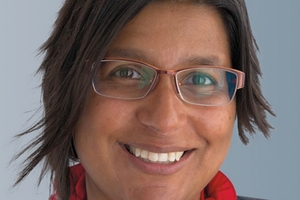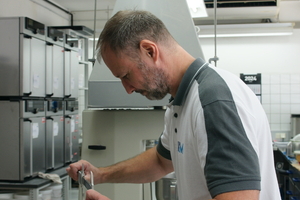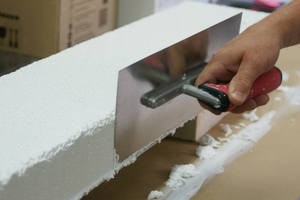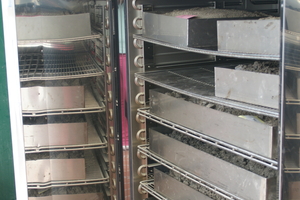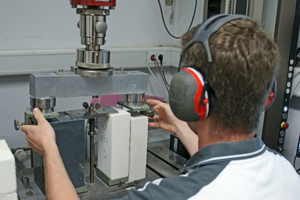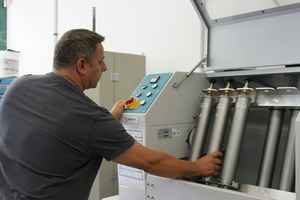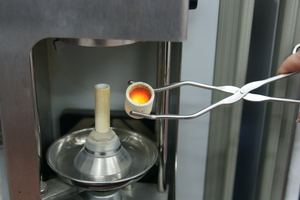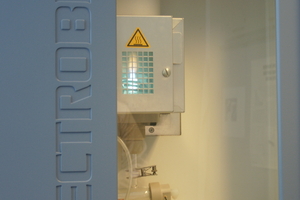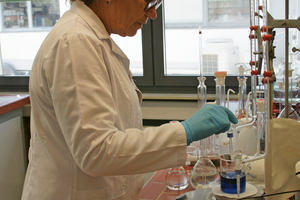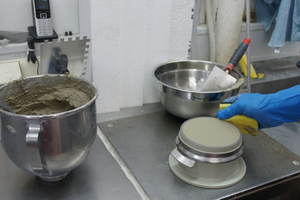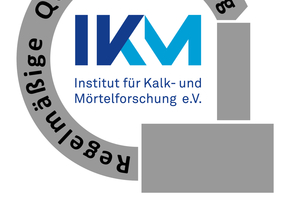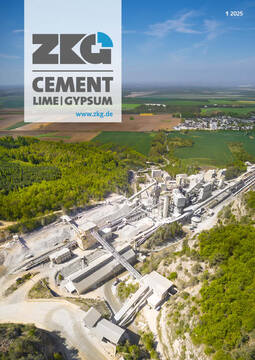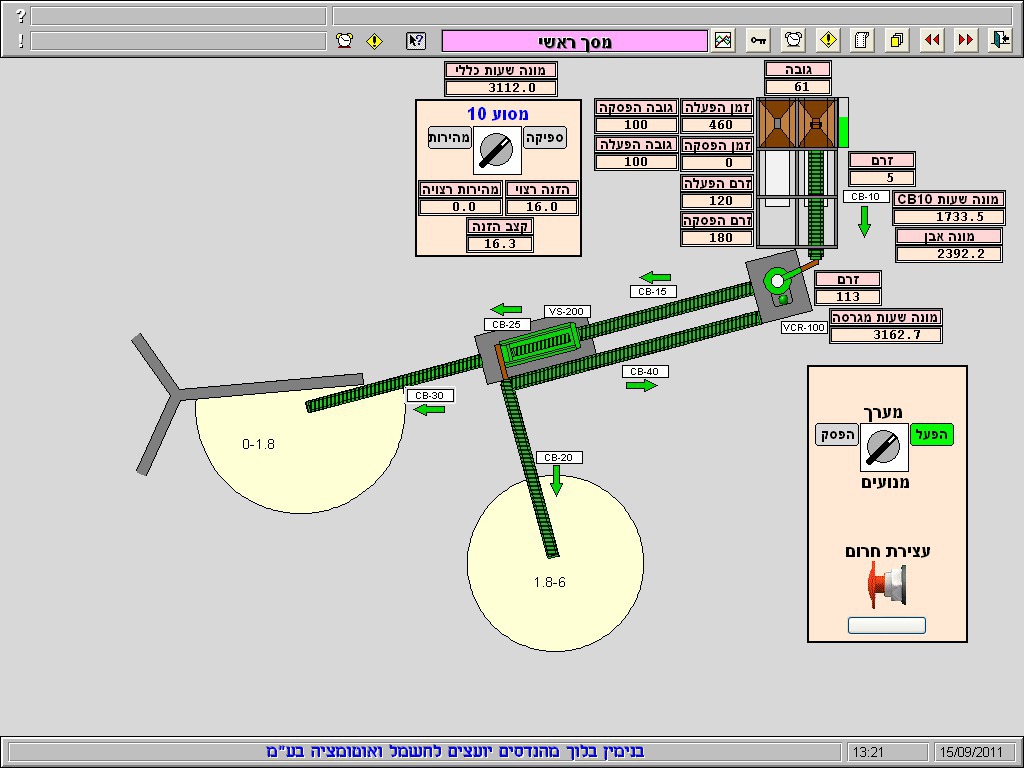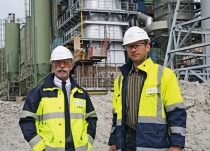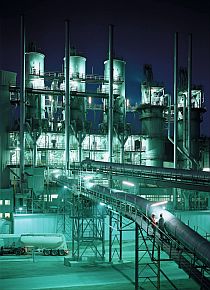We value credibility and trust Interview on the work of the Institute for Lime and Mortar Research and its new test seal
One of the latest achievements of the Institute for Lime and Mortar Research (IKM) during 2024 has been the IKM Test and Quality Seal. This seal was developed with the greatest of care in accordance with customers’ wishes and registered at the German Patent and Trade Mark Office as a protected trademark. And the IKM Test and Quality Seal is more than merely a marketing tool. It is based on thorough testing and on adherence to demanding quality standards in order to ensure that it provides a dependable differentiation of the products tested – something for which the claim included in the IKM test symbol ‘Regular Quality Inspection’ also stands (see Infobox 1).
ZKG Cement Lime Gypsum took the opportunity to speak with the head of the IKM, Dr Annamaria Fiethen, on the subject of the new seal and also on the many other diverse tasks and functions of the IKM and on her own personal career as the head of the IKM.
Dr Annamaria Fiethen studied biochemistry in Bochum, completing her course with a diploma degree. This was followed by a doctorate in theoretical chemistry between 2005 and 2009 on the topic of “Analysis of intermolecular interactions in biochemical modelling systems using symmetry-adapted perturbation theory in combination with density functional theory”. Roughly summarized, this involved the understanding of long-range interactions, so-called stacking interactions, between, for example, adjacent DNA base pairs. So: very distant from Dr Fiethen’s current field of work! Late 2009, in the midst of the financial crisis, was a difficult time to make a new start. Dr Fiethen found a post with a small company which performed contract research in the form of molecular dynamic simulations for major companies (such as Henkel, Clariant and Evonik). In addition, she has also worked as a Business Development Manager in the chemicals and pharmaceuticals industries. She has been with the Association of the German Lime Industry (BVK) since January 2022. She is at present the head of the Institute for Lime and Mortar Research.
Dr Fiethen: The unifying thread running through my career over the years were both project management and project leadership. But what I always really wanted to do was lead and manage people, because that is the greatest challenge of all. No single day is ever the same but brings something new. The scope of my function as the head focuses on the strategic and operative management of the IKM. My job is that both the employees and the organisation are thriving. Together with the team I define the orientation of the institute regarding new branches of interest but also optimizing our traditional already existing areas. Above all it is my duty to ensure that the institute operates on a secure financial footing.
Dr Fiethen: The IKM is a registered association and embedded into the Federal Association of the German Lime Industry (BVK). The IKM is subdivided into three units: the Chemistry department, the Aggregate department and the Construction Materials department.
Twenty-one specialists work in these three groups and they achieved a turnover of more than two million euros in 2023 – which I personally find a magnificent achievement. This also demonstrates how capable we are and what excellent expertise we can offer.
The Chemistry department is the one with the oldest tradition: This is where the topic of building lime resides. Our Dr Schiffner is the recognised expert in this field and was also the head of the Chemistry department until 2023. This department performs tests and analyses on lime, lime-based and dolomitic products for building lime, drinking-water purification, tests on lime with hydraulic properties, tests according to EN 413, Part 2 on plasters and masonry cement and testing of hydraulic road binders (HRBs). Both instrument-based and wet chemistry analytical procedures are employed. In the more distant past, only member companies could have their products tested here but we have been accredited according to ISO 17025 since 2004. So now our range of services is available to all interested parties.
The Aggregate and Road construction department conducts tests and analyses in accordance with standards within the framework of DIN and the German Road and Transportation Research Association (FGSV) as part of its function as RAP Stra notified body.
Only the Filler Materials unit is accredited.
The department of Construction Materials tests ready-mixed dry mortar, thermal-insulation-compound systems, restoration plasters, lightweight aggregates and other construction materials. This department systematically exploits new opportunities on the construction materials market. You can find our test portfolio on our homepage.
Customers frequently approach us because of a recommendation - the news of the quality of our services quickly gets passed on! I can proudly say that the IKM enjoys an excellent reputation which was built up over decades. We have even received samples from Saudi Arabia. We strive to continue to develop the institute and continuously optimize our processes. But that also means, of course, that we have certain obligations and can never lose sight of your main aim: To deliver outstanding quality constantly and to be a reliable partner whenever our customers need us.
My team also considers new opportunities to grow further. The construction industry is currently going through a difficult period. Additionally, skilled workers are hard to find, and the economic factors are also challenging now. That not being enough, the question of sustainability hangs over everything. Burning one ton of limestone releases more than 600 kg CO2.
Attempts to combat this include conceptual technical solutions, pilot and lighthouse projects. We are confronted with great challenges here, however, we are talking about a great deal of money and about a gigantic scale as well. But truth be told: Limestone has hundreds of possible uses and is present in numerous everyday products such as steel, paper and glass, to name only a very few. This is why committee work is so very important for the German lime industry; we’re talking about the committees of the FGSV as well as national and international standardisation groups. I take part in several national and international committees within my field of responsibilities.
Dr Fiethen: It is extremely exciting to support the processes of standardisation. An important factor is ensuring that standards - all of them - stand on a secure legal basis. Sustainability plays an important role and has a significant influence on standardisation activity. Both start-ups and well-known companies are now offering so-called “green” cements and concretes.
Greatest attention is devoted to the environmental aspect but we’re still lacking long-term experience with these new materials and that aspect is of great importance. In the case of cement and concrete, we know the conditions under which they remain resistant and stable for a very long time. This is why I think it is too early to abandon the tried-and proven materials present on the market.
A whole series of additives is also currently under discussion: With the aim of reducing CO2, these will, for instance, replace classical binder components. And here standardisation is important, too, because it sets the framework within which we can safely move. Who can guarantee me – and everyone else, for that matter- that the alternative materials deliver the same performance and have the same durability? No one can and should replace or modify a substance used in constructing a building if they are not certain that the final structure is and remains stable.
The same applies to the materials used in highway construction. The condition of our roads already leaves a lot to be desired in many instances. The corresponding codes and standards do have their justification. There are people who view those regulations as excessive or too extensive. And there are, indeed, many things that feel exactly like that – too complex, too much, too many exceptions or invisbible connections. In one word: Overwhelming. But strict criteria must be applied for quality, for durability and for long-term stability, otherwise safety will suffer or be completely eliminated.
Dr Fiethen: That should certainly be considered. But I pose a counter-question: What do we mean with ‘simplify’? Does it mean executing fewer tests and analyses? Easier approval? Because: The consequences of such simplifications cannot be foreseen. What if a new material has not been sufficiently tested and fails in service? A Substitute Building Materials Ordinance to conserve primary resources came into effect in August 2023. That sets a good example. But the question does arise of whether a recycling material that fulfils environmental aspects will also meet technical building requirements.
The process as a whole is very complex, given the plethora of new materials appearing on the market. And let’s not get started on the level of bureaucracy… What I ‘m saying is: It‘s good that we have standardisation. And it’s good that the companies – and not only the prominent ones - are researching, developing and testing to evaluate new construction materials. But it will not be possible to change everything just overnight. Long-term results will also be needed and it’s crucial to gather them.
Dr Fiethen: This process started, in fact, before my time at the IKM. A customer approached the IKM – or, more precisely, the Construction Materials department - and expressed the wish to have a symbol to separately highlight a specific characteristic of his material. And he wanted that symbol to be found not only in the enclosed data sheet and therefore remain invisible but to print it directly onto the product’s outer packaging to be seen and acknowledged.
The seal was developed in close cooperation with our customers. It is patented and can be used flexibly – all depending on which characteristic or standard shall be integrated. And it is free-of-charge. However, the seal can be obtained only if the manufacturer had corresponding tests and analyses on the very material performed prior at the IKM. It is directly connected to regular product tests and their intervals and frequencies are specified in the relevant standards. This seal of approval is intended to be a sign that the product is durable and reliable. It also means that there exists a corresponding test certificate – proving that there is precise and detailed documentation meaning the seal cannot simply be purchased.
It shall demonstrate the manufacturer’s transparency and the Institute’s independence.
The IKM logo is centrally located on the seal and signals to the buyer: ‘This is a special product’. There are two grey areas on the seal: The customer can highlight particularly relevant test values in one. The second grey field contains the IKM product number under which all tested parameters are stored at the IKM. The basic design is adapted into a unique presentation. This is done in close cooperation with the customer. Finally, the finished quality seal is produced in the format requested by the customer.
The IKM seal is intended to assure end customers of the product’s reliability and certainty that this is a monitored high-quality product: The product fulfils specific requirements and is tested by an independent institute at regular intervals, thus reflecting credibility and trust.
https://www.ikm-koeln.de/

